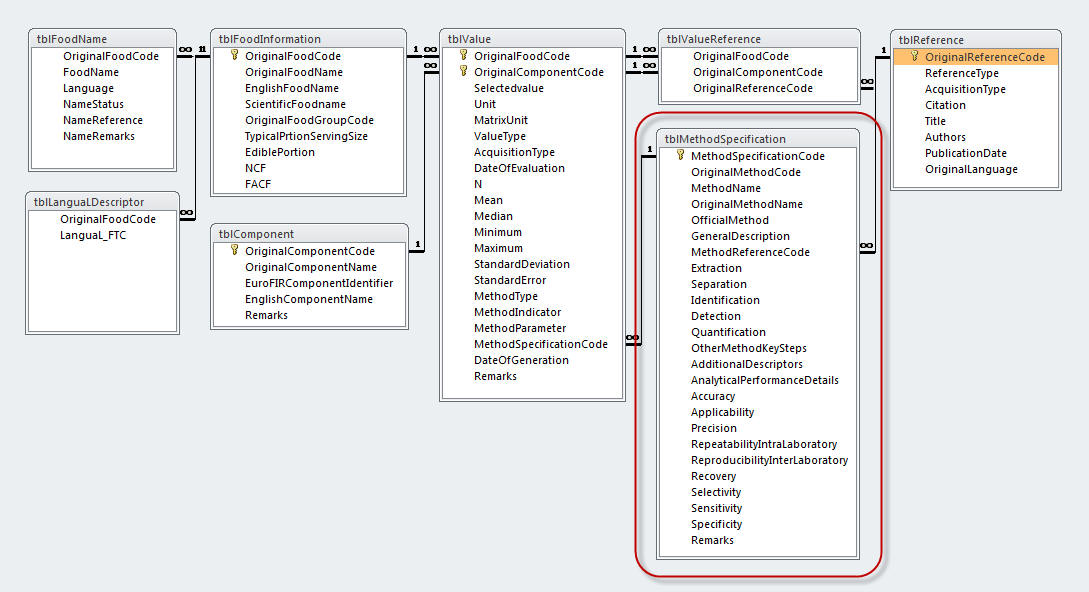Method | |
| Updated 2017-04-30 | |
| Method - the ways to determine values in food composition databases |
![]()
In a broad sense, the term 'method' in food composition refers to the way a certain value has been derived for presentation in the food composition database or table, i.e. has the value been obtained by analysis, by calculation or by deduction, e.g. from another food or by logical deduction.
It is important to indicate how the specific values in a food composition table/database have been derived - is the value a result of chemical analysis, a calculation or estimated/guess (a "guestimate")?
In the draft EuroFIR standard, the value is described with a
series of mandatory descriptors using predefined controlled terms in
the form of thesauri.
The overall and mandatory value description follows the value
closely - in the figure below in the Value table - with Value Type,
Acqusisition Type, Method Type, Method Indicator and Method
Parameter information. All defined by controlled vocabularies, the
socalled EuroFIR Thesauri.
The method specification is a main (currently not
mandatory) entity in the draft EuroFIR standard's table metaphor
contains detailed description of the analytical or calculation
method used to derive the specific value.
The content of the method specification (shown with a red frame in
the simple database layout below) is mainly intended for specific
chemical (and microbiological) analytical information, but is also
suitable for detailed description of calculation methods. The
information occupies a database table of its own.

The Eurofoods Draft Standard (and its Technical Annex) was further refined with the EuroFIR Food Data Transport Package, which in details refined and expanded the previously defined entities.
| References |
![]()
- Codex Alimentarius Commission - Codex Committee on
Methods of Analysis and Sampling:
CODEX STAN 234-1999 Recommended methods of analysis and sampling (revised 2013)
- Food energy - methods of analysis and conversion factors.
Report of a technical workshop, Rome, 3-6 December 2002.
FAO Food and Nutrition Paper 77
FAO, Rome, 2003.
- Schlotke F., Becker W., Ireland J., Møller A., Ovaskainen
M.L., Monspart J., Unwin I.:
Recommendations for Food Composition Database Management and Interchange.
Report by the COST Action 99 – Eurofoods Working Group on Food Data Management and Interchange.
Report No. EUR 19538, European Commission, 2000.
- Schlotke F., Becker W., Ireland J., Møller A., Ovaskainen
M.L., Monspart J., Unwin I.:
Eurofoods Recommendations for Food Composition Database Management and Interchange.
Journal of Food Composition and Analysis, 2000, 13, 709-744.
- Becker W., Unwin I., Ireland J., Møller A.:
Proposal for structure and detail of a EuroFIR standard on food composition data.
I: Description of the standard.
EuroFIR Technical Report - 2007-07-13.
- Becker W., Møller A., Ireland J., Roe M., Unwin I., Pakkala H.:
Proposal for structure and detail of a EuroFIR Standard on food composition data.
II. Technical Annex - Version 2008. EuroFIR Technical Report D1.8.19.
Danish Food Information 2008. ISBN 978-87-92125-10-1. ( pdf file, 4.5 MB formatted for duplex printing)
pdf file, 4.5 MB formatted for duplex printing)
- Møller A., Christensen T.:
EuroFIR Web Services - Food Data Transport Package, Version 1.4.
EuroFIR Nexus Technical Report D2.1.
Danish Food Information 2012.
ISBN 978-87-92125-15-6.
- European Standard 16104:2012:
Food data - Structure and interchange format.
European Standard approved by CEN on 3 November 2012 (preview).
(preview).
![]()
| ||
| ||
| ||
| ||
|